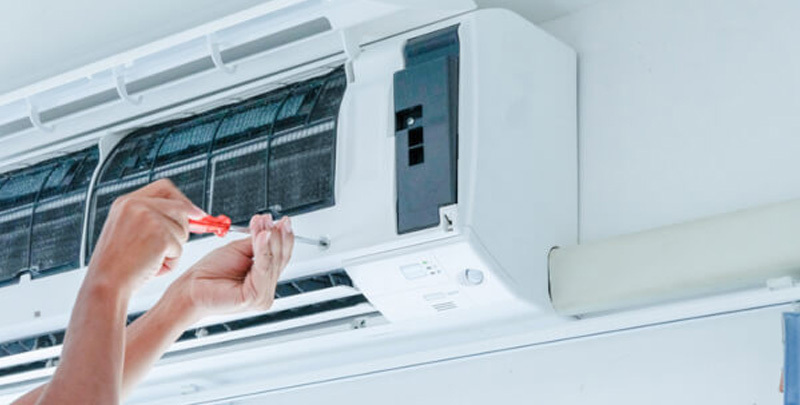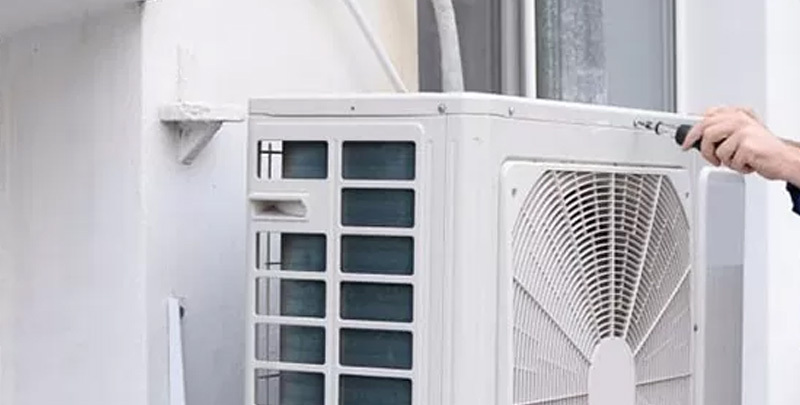Everything You Need To Know About Aircon Installation
Published on : January 19th, 2024

Looking to beat the hot weather with a new air conditioner? Savvy decision!
While air conditioner installation might seem daunting to many, it simply requires careful planning and understanding. Let’s kick off by understanding your options for air conditioning systems.
Air Conditioning Systems: The Basic Types
Before we proceed with the actual process of air conditioner installation, it’s important to have a basic understanding of the different types of air conditioning systems given their unique installation and maintenance methods required.
To get started, here are the most common:
-
Split System Air Conditioner
Split system units are divided into two main components: the indoor unit and the outdoor unit. The indoor unit is typically mounted onto the wall within the room which requires cooling or heating. This is connected to the outdoor unit, responsible for dispersing air outside.
Split air conditioning systems are a popular choice due to their energy efficiency and flexibility to cool or heat a single room or a specific area of a house. They are perfect for those who want to control the temperature in individual rooms. Additionally, in the event of a technical issue, the problem will be isolated to one room without affecting the entire house.
-
Ducted Air Conditioning System
Ducted air conditioning systems operate through a series of ducts and vents to cool or heat the entire house. The main unit is typically placed outside the home with ducts running from it into each room. This type of system offers the convenience of warming or cooling the entire house in one go, with adjustable control for each room.
Ducted systems are great for larger homes and offer a much cleaner and unobtrusive look because the bulk of the unit is hidden, with only the vents being visible.
-
Portable Air Conditioner
Portable air conditioners are standalone units that are flexible and can be moved from room to room. They are best suited for rental properties or for those who are cost-conscious. They work by pulling in air from a room, cooling it and then directing it back into the room.
While they are the more budget-friendly option, they are generally not as effective as other permanent solutions in cooling or heating a room.
-
Window Air Conditioner
As the name suggests, these air conditioning units are designed to fit in standard windows. They are a more affordable option and easy to install. However, they’re most effective for smaller rooms.
Window air conditioners are a single unit that expels heat out of one end (the outdoor side) and cools the room on the other end (the indoor side).
-
Box Air Conditioner
Box air conditioners, also known as window/wall air conditioners, are installed into a window or a hole in a wall. Similar to the window aircon, the box aircon is a single unit and easy to install. Unfortunately, they are not especially energy efficient and can be noisy, but they are a more affordable option compared to more complex systems.
Remember, each type of air conditioner has its pros and cons, so be sure to consider your specific cooling needs, scenario, and budget when deciding which air conditioner to install.

What Factors Impact Aircon Installation?
Setting up an air conditioning system isn’t as simple as plugging in a device. Various factors influence the aircon installation process, ensuring optimal performance and prolonging the system’s lifecycle.
-
Space Constraints
The first thing to consider in the aircon installation process is the available space. Both for split systems and ducted systems, space plays a huge role in the setup. Indoor units of split system air conditioners are normally wall-mounted, requiring wall space that is conveniently located and clear of obstructions for optimal performance. Similarly, for ducted systems, necessary ceiling space is required for duct installation.
-
Location and Environment
Where your abode is situated will influence your aircon installation significantly. For instance, if your house is exposed to high levels of sunlight, you might potentially need a more powerful cooling system.
Also, the outdoor components of your air conditioning system need to be placed in a spot where they can easily exhaust heat. Placing it in direct sunlight could impact its performance adversely, so a shaded, well-ventilated area is ideal.
-
Electrical System Readiness
Your home’s electrical system must be prepared to handle the additional energy load that an air conditioner will bring. If your current electrical system isn’t up to snuff, you might need to require an upgrade, which could add to the overall installation expenditure. Always consult an expert to ascertain the readiness of your electrical system before proceeding with the installation.
-
House Layout
The layout of your house is a fundamental factor impacting aircon installation. For example, a house with multiple levels or a more complex floor plan may entail a more complicated installation process or the use of more than one air conditioning unit. On the contrary, a house with an open floor plan might be adequately served by a single, strategically placed split-system air conditioner.
-
Insulation Level
The level of insulation within your home affects how effectively your air conditioner can maintain the right temperature. Homes with good insulation keep cool air inside during summers and warm air during winters.
If your home’s insulation isn’t up to standard, your air conditioner might need to work harder than it should, potentially reducing its lifespan and costing you more in energy bills.
-
Number and Size of Rooms
This is a no-brainer! The number and size of the rooms you wish to cool or heat will impact the type and number of air conditioning units you’ll need. A larger room or an open-plan living area might need a more powerful system, while a smaller room could be adequately served by a less powerful unit.
Remember, installing an air conditioner isn’t simply a matter of plugging it in. Careful planning and consideration of these factors will ensure you get the best out of your air conditioner, keeping your home at a comfortable temperature all year round.
Steps in the Aircon Installation
Installing an air conditioning system is a process that requires proper planning and methodical execution.
From choosing the most suitable air conditioner based on your specific needs, selecting the optimal location for installation, ensuring secure mounting, making necessary connections, to testing and final clean-up – each step plays a crucial role in a successful aircon installation.
- Choosing the right aircon type: Your first step is to decide on the appropriate air conditioning system for your home. This decision should be based on factors such as the size of your home, the number of rooms, insulation, and your budget. Consulting a professional can provide valuable guidance in making the right choice for your specific situation.
- Selecting the ideal location: After settling on an aircon type, it’s time to pick the perfect spot for the installation. The indoor unit should be mounted in an open space on the wall, at a proper height, away from any obstructions. For outdoor units, select a shaded, well-ventilated area with minimal exposure to dust and other debris. This step is crucial for the optimal performance and longevity of your aircon system.
- Affixing mounting equipment: For split system installations, wall brackets need to be fitted securely on the inside of the room to hold the indoor unit. Similarly, brackets for the outdoor unit must be installed, ensuring a stable foundation for the unit. In the case of ducted systems, the installation of duct channels will be required, following a strategically planned design.
- Connecting the indoor and outdoor units: During this step, the indoor and outdoor components of the air conditioning system are connected. In the case of split systems, this involves running tubes for refrigerant, drainage, and electrical connections. For ducted systems, it would include connecting the main unit, to the vents throughout the house with the help of ducts.
- Electrical connections: Ensuring safe electrical connections is paramount during aircon installation. This will require a licensed electrician who will connect the air conditioner to the home’s main electrical supply, making certain that your electrical system can handle the additional power load.
- System testing: After the installation is complete, a thorough test of the newly installed air conditioning system is necessary. This step verifies that everything has been installed correctly, that there are no leaks or loose pipes, and that your system operates efficiently.
- Final touches and clean-up: The final step in aircon installation is tidying up the site and sealing any holes made during the installation process. This may include sealing any drilled wall holes, securing ducts and pipes in place and making sure the indoor and outdoor units are firmly installed and ready for use.
It’s important to remember that proper aircon installation is crucial for long-lasting and efficient performance. For this reason, working with a professional installer is your best bet for ensuring a successful installation, which will keep your home comfortable during those hot Aussie summers and cool in winter.

The Role of an Air Conditioner Installer
A professional air conditioner installer, holding an air conditioning license, is key to the setup of your air conditioning. Expert installers ensure the setup is energy-efficient, leading to lower energy consumption and reduced running costs. From the placement of your split system air conditioning to ensuring safe electrical connections, they pay attention to every detail that can affect your global cool air experience.
Why is Regular Maintenance Essential?
Air conditioners, like other appliances, have an average lifespan. But, regular maintenance can extend this lifespan whilst ensuring your aircon proffers maximum cool air during hot weather and warm air in colder months.
Maintaining optimal air quality is another benefit of regular maintenance of your aircon by checking filters and cleaning them out regularly. Trust us, it’s no fun having an aircon that’s making you sniffle every time it’s powered on!
A True Investment
Regardless of the air conditioner cost, recognise that air conditioning installation is an investment, which if done correctly, adds value to your home and enhances comfort for you and your family. And while the process can seem a bit overwhelming at first, understanding your options and potential challenges can help make the decision-making process smoother.
So whether it’s a sweltering summer or a chilly winter, you’ll be prepared with your air conditioning running perfectly. Equip yourself with the knowledge, make informed decisions, and welcome home comfort like never before from your new air conditioner.
Please note: This information is provided for advice purposes only. Regulations differ from state to state, so please consult your local authorities or an industry professional before proceeding with any work. See our Terms & Conditions here.